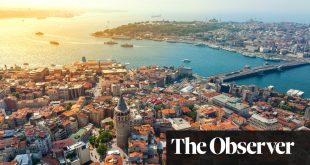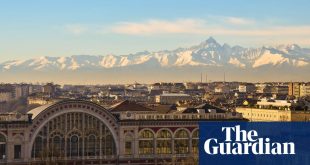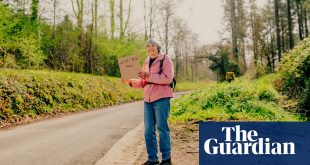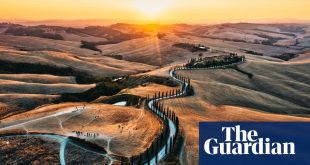Wearing a crimson and sunshine-yellow flower crown, the young man is surrounded by his family, before there is the pop of the vino frizzante and the royal blue cups are filled for a merry toast to celebrate his graduation.
The fading afternoon light dances on this scene taking place near the small central Fontana Contarini in Piazza Vecchia, in Città Alta in Bergamo, the medieval upper part of the city. With its 16th-century Venetian walls and flourishing restaurants under large stone archways, the area invites people to pour in from every direction.
I arrive in the square in a tuk-tuk as part of a tour with guide Elisabetta Campanini and we wander past the Campanone, the city’s clock tower, whose bell I’m told will chime 100 times at 10pm, a perennial reminder of the closure of the city gates during the Venetian domination. At the top, accessible by foot (230 steps) or more comfortably in the lift, there is a vista across the city and a bird’s-eye view of the handsome basilica of Santa Maria Maggiore below.
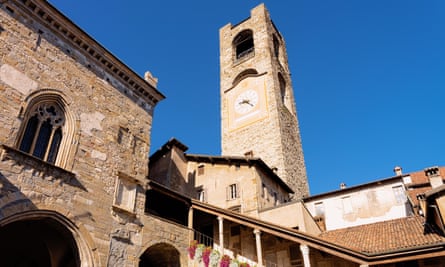
We make our way down and into the basilica – built almost nine centuries ago in gratitude to the Virgin Mary for warding off infections from a plague spreading across Europe. A work of unashamed opulence, large tapestries in deep greens and golds adorn the walls. They were woven by hand in craft workshops in Florence and further afield in Flanders, and everywhere you look there are frescoes and stuccos designed by the Italian Renaissance painter Lorenzo Lotto. But, for me, the basilica’s most curious features are the medieval paintings next to its portals. Hidden for centuries after being painted over, some have now been restored. The colours are flatter in these works but they are no less beguiling than their more recent counterparts.
We spend the afternoon strolling across the city as Elisabetta explains that Bergamo and its neighbour, Brescia, have always been somewhat overshadowed by Milan, capital of the northern region of Lombardy. But in just a few hours, watching the Bergamese go about their daily lives and later, during an afternoon in Brescia – known for its arts scene and Roman relics, including the Santa Giulia Museum, part of a complex that was granted world heritage status in 2011 – it is obvious both are teeming with fascinating architecture and good food, and offer ample access to nature. This year, the cities are pausing a 900-year-old feud (more recently fuelled by the rivalry of supporters of its football teams, Brescia Calcio and Bergamo’s Atalanta BC) to become Italy’s first joint capitals of culture.
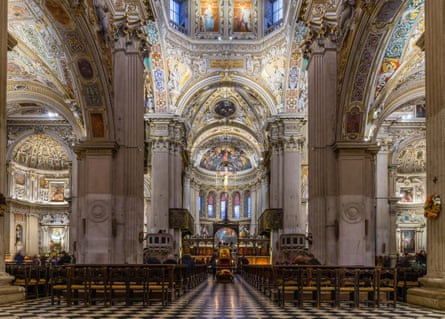
Both cities were badly affected by the pandemic: they were at the heart of the first wave of coronavirus in Europe, with ambulance sirens pealing out across the region day and night. Thousands lost their lives. The episode continues to haunt many of the residents, a look of deep sorrow passing across faces every time it is mentioned.
Yet, there is a general sense of trying to shake off the pandemic with tourism and a new 80-mile (130km) hiking trail, La Via Delle Sorelle (The Way of the Sisters), has been created to link the two cities.
Matteo Zanga, a mountain leader, is to be my guide for a 12-mile walk along the trail, and we set off one early morning from the provincial village of Olera. We weave our way through the hillsides with the scent of wild garlic in the air and white wood anemones providing a carpet.
The route meanders alongside farms and through woodlands and we take a detour to see Ristorante Pighet, which is being revamped and is due to reopen later this year. As we make our way back on to the trail there is another opportunity for a pitstop and a glass of wine at an alpine festival, taking place in an opening alongside the trail.
It is recommended that the trail, in the north-eastern corner of Lombardy and which features works of contemporary art, is completed in six stages, with places to sleep and eat along the way. It passes through four parks and reserves, sloping down toward Lake Iseo, and joins up with the Strada del Vino, a path that passes through the Franciacorta, Valcalepio and Terre del Vescovado wine-making regions, with opportunities to stop off for tastings.

After passing a group of female friends, who are intending to complete the trail, we make our way back into the Città Alta, and go for lunch at Baretto, in the upmarket, hilltop San Vigilio suburb, and this is where my opinion of the city, and the region as a whole, is cemented.
Making our way through the hubbub of people waiting for the funicular railway down to the Città Alta, we take a seat on the restaurant’s terrace, where I order the traditional bergamasco appetiser of polenta, butter and anchovies, with the silvery seafood providing a nice hit of sharpness to the dollop of nutty cornmeal. The mango sorbet cleanser is exquisitely fresh as is the tiramisù del Baretto and there is much good-humoured laughter from Matteo when I order a cappuccino to finish, as Italians apparently only drink milky coffee in the morning.
after newsletter promotion
“There’s so much more here than just religious buildings: it is all about the food and the people,” says Matteo. “Every place has its own speciality and when they do something, they do it very well – that is the best we have to share,” he adds.
It’s true. During my visit I find people celebrating local ingredients in everything they create. During a guided tasting at Bu Cheese Bar, the owner, Pedro Domenghini Albano, introduces me to delightful morsels, from a soft stracchino, which has the consistency of melted butter and an undertone of fresh mushrooms, to the strachitunt from the Taleggio valley, with its grassy, sweet undertones. There is anticipation in his face as he waits for my verdict after each tasting, and excitement as he tells me about a new project offering in-depth tours in the region’s “cheese valleys”.
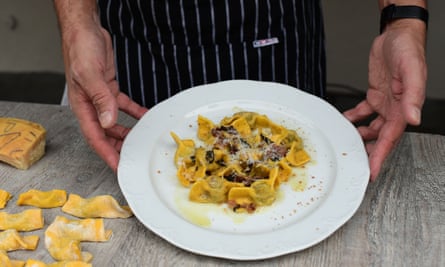
There are similar experiences in the well-located Trattoria Sant ‘Ambroeus and at the more traditional Ol Giopì e la Margì, where the food is delightful. My favourite meal comes at the end of my trip, at the simple Osteria al Bianchi in Brescia, run by the Masserdotti family since 1976. It might be because you can still buy a glass of wine for €1 (85p) if you drink it standing at the bar; or the fact that it is a humble affair of good ingredients cooked simply, from the malfatti al burro versato (balls of spinach and ricotta in a lemon butter sauce) to the melt-in-the-mouth costata alla griglia (grilled and finely cut ribs) washed down with glasses of sparkling Franciacorta The grapes for this are grown on the hills between the southern shore of Lake Iseo and Brescia.
In the end, I decide, it’s the people. After the meal we take our drinks outside and as the light dips behind the buildings painted in warm shades of pink and yellow, and a family enjoys a lively meal on a terrace above, there is a chance meeting with Barbara Cavellini, who happens to be the granddaughter of Italian artist and collector Guglielmo Achille Cavellini. Barbara speaks affectionately of her grandfather and how he once had his portrait painted by Andy Warhol, as her partner, Giovanni, fills our glasses with the elegant Arcari e Danesi wine that he is producing on the slopes of Lombardy.
There is a wonderful warmth in the conversation, a willingness to include and to share, and this has been my experience all along the way. Two cities that will not allow themselves to be shackled by the devastating impact of the pandemic, but are determined to invite outsiders in and show them that sometimes, out of the worst circumstances, something beautiful can exist.
The trip was provided by Italian Capitals of Culture 2023
 Top Naija News: Nigerian News, Breaking News Nigeria and World News Top Naija News is a daily news publication in Nigeria, delivering the latest breaking news in Nigeria and around the world.
Top Naija News: Nigerian News, Breaking News Nigeria and World News Top Naija News is a daily news publication in Nigeria, delivering the latest breaking news in Nigeria and around the world.
